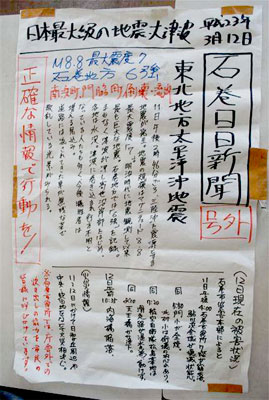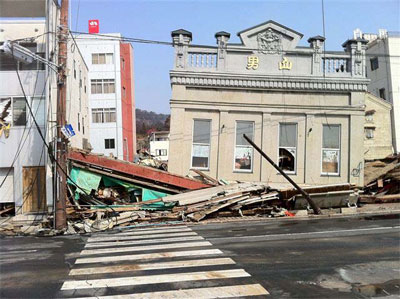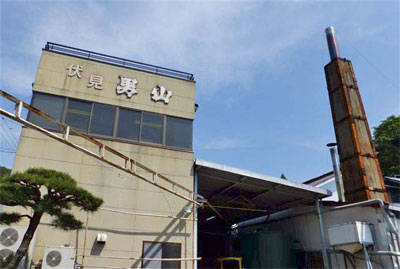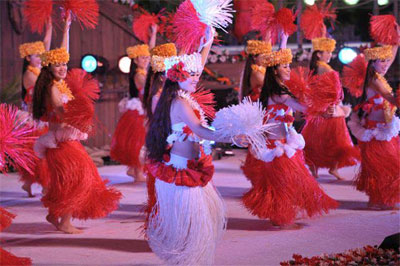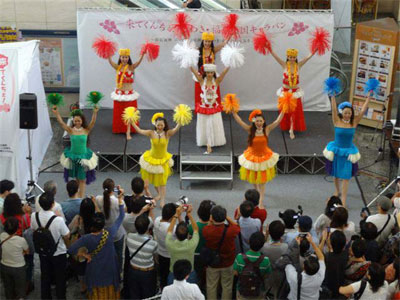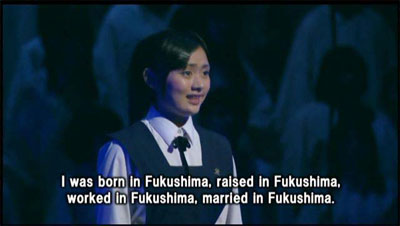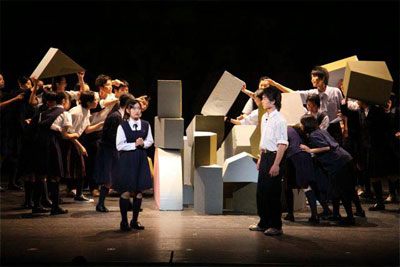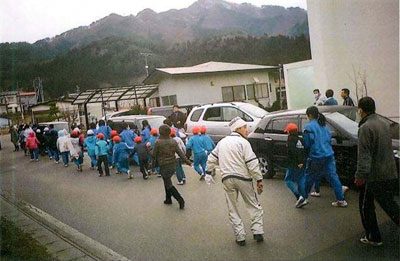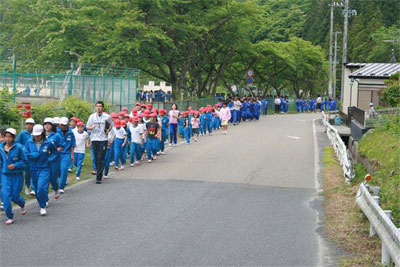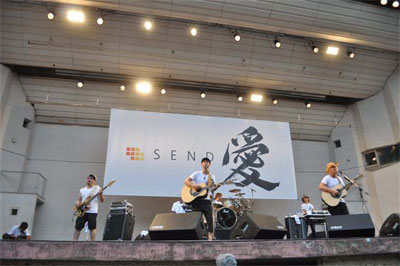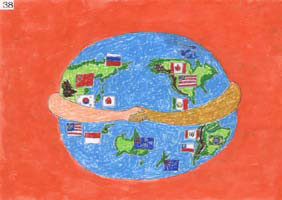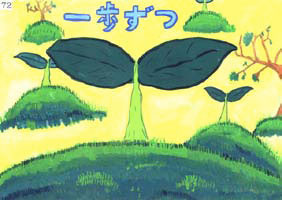Představíme Vám malé příběhy po zemětřesení
z postižených oblastí a okolí
Handwritten Newspapers published by Ishinomaki Hibi Shimbun
Ishinomaki Hibi Shimbun is a local evening newspaper which was first published in 1912 in an area of Miyagi Prefecture covering Ishinomaki City, Higashi-Matsushima City and Onagawa-cho (in Oshika County). When the Great East Japan Earthquake hit the company, the ensuing tsunami left the first floor of its office building flooded and two printing presses on the second floor partially flooded. However, miraculously, the building itself remained undamaged. However, with electric power and other infrastructure destroyed, they could not operate the printing presses. The staff of the company were unable to return home, could not have enough food and were not even sure about the safety of their families. Feeling their "mission to report", by using roll paper for newspaper and felt-tipped pens, they wrote articles on the situation of disaster damage, restoration of life lines, and relief activities, while staying inside the company or their cars. And, they posted hand-written newspapers on the walls of evacuation centers for six days, from March 12 to 17. On March 18, the Ishinomaki Hibi Shimbun was published in A4 size by using copying machines and, on March 19, the printing presses were back to work, consequently keeping the daily published without a single day of suspension after the earthquake. Information thus delivered to disaster-stricken areas, where information was confusing, gave hope to local citizens who needed accurate information.
In September, the International Press Institute (IPI), at its annual meeting, gave a special award to the newspaper company, for its contribution. Also, Newseum, a news museum in Washington D.C., United States, displays some of the wall papers, donated by the Ishinomaki Hibi Shimbun at the museum's request, as the historic newspaper which was published overcoming the difficulty.
Although the newspaper employees still suffer hardships, some living in damaged
houses, they keep publishing the newspaper, convinced that continuing to publish the Ishinomaki Hibi Shimbun will lead to sustaining local communities.
The handwritten newspaper of 12th, March 2011
Sake brewery "Otokoyama Honten" in Kesennuma City, Miyagi
– Symbol of Reconstruction –Otokoyama Honten, a sake brewery in Kesennuma City, Miyagi Prefecture, was founded in 1912. Its three-story main office building, constructed around 1931, was designated as an cultural property by the government in 2003 for having kept the cityscape of the early years of the Showa period (1926-1989). On the day of the Great East Japan Earthquake, the building was destroyed by a vessel which was washed up by the tsunami. The brewery's warehouse, where raw materials were stored, was washed away. However, the tsunami stopped a few meters short of the entrance to its brewing house, which was on higher ground. Thus, brewing equipment and tanks (in which sake
2 was brewed and stored) escaped damage. Today, Otokoyama Honten produces and ships sake brewed with the equipment that escaped damage.
At the time of the earthquake, fermenting mash for the "Sotenden" sake brand was contained in two tanks inside the brewery's warehouse. To protect the unrefined mash, the brewery's president, Akihiko Sugawara, went to the brewing house the next morning of the earthquake with two of his employees. As there was no electric power, water or gas supply, Mr. Sugawara continued the work to control the fermentation of the mash by using ice found in the brewing house and a battery-operated thermometer because control of temperature is important during fermentation.
Ten days after the earthquake, the unrefined mash was ready for the press, though a little ahead of the original plan. There was still no electricity or water, although, to press the unrefined mash, electricity for operating the machine and water for cleaning are necessary. If fermentation further continued, the mash would not make good sake. As ice ran out, as well as electricity and water were not available, Mr. Sugawara was at a loss. When walking in town one day, he found a large generator with the help of some local residents. They also helped him find a truck to carry the generator, fuel to operate it, wiring for electricity, and water. He managed to install the generator with the help of friends. He then was able to press the fermented mash for the first bottle of sake on March 21 and for the second bottle on March 24.
Mr. Sugawara says that at that time he had strong qualms about using a lot of electricity and water to press the mash when the entire city had been stricken by the disaster, with many people having lost everything and there was no electricity or water supply in town. However, every person who had helped him urged him to continue, saying, "the tsunami has destroyed many industries and almost all of our local products are gone. Fortunately, your brewing house still remains. We want you to keep on at any cost." These words prompted Mr. Sugawara to press the mash to make sake.
After the earthquake, this story of Otokoyama Honten was widely covered by the Japanese press, and orders poured in from across the country from people who wished to help the brewery. Mr. Sugawara tells his employees that they are making this sake not for the company but for the people of Kesennuma City. He also tells them that it is the mission of a surviving producing facility to stabilize production, employ more local residents and continue to promote Kesennuma. Mr. Sugawara hopes to cultivate new marketing channels in the future rather than depending on his supporters, and keep the company going.
The main office building after the earthquake and tsunami
Sake brewery of Otokoyama Honten
Iwaki Spa Resort Hawaiians
– Hula Girls from Fukushima cheering up Japan –Spa Resort Hawaiians, a resort complex in Iwaki City, Fukushima Prefecture, managed by Joban Kosan Co., started in 1966 as the Joban Hawaiian Center, which is a hot-spring resort, when once booming coal mines were declining there. The main
attraction of the resort was the Hawaiian dance team "Hula Girls", consisting of local residents, who went on a performance tour around the country in 1965 when the team was formed and 1966 to overcome a crisis that gripped the resort in its inaugural days.
The resort was hit hard by the Great East Japan Earthquake and had to be closed for a time. However, it resumed a part of its operations in October 2011 and, on February 8, 2012, the whole resort was back in business with a new facility added.
The Hula Girls are mostly from Iwaki City. While the resort was shut down following the earthquake, the Hula Girls went on a nationwide performance tour for the first time in 46 years. Called "Hula Girls National Kizuna Caravan," the girls began their tour with a comforting performance at an Iwaki City evacuation shelter on May 3, 2011, hoping to spread smiles and good spirits across the country. The Hula Girls held 247 performances in 124 places in 26 prefectures, including disaster-stricken areas in Fukushima Prefecture and other prefectures in north-eastern Japan as well as parts of Nagano Prefecture struck by a separate major earthquake. Among other performance places were shelters in and around Fukushima Prefecture and in the Tokyo metropolitan region, cities having parent-and-child and sister city relations with Iwaki, coal mine-related localities in Kyushu and Shikoku, and Kobe and Hiroshima, cities that have successfully recovered from disasters.
A documentary film, "Cheer up! Hula Girls – Living in Fukushima, their present situation –" , directed by Masaki Kobayashi, was released last year. It depicts the Hula Girls and people working at the spa resort who, despite their own suffering from the disaster, always wore a smile on the stage, trying to encourage disaster victims in the wake of the caravan, and also depicts affected people making untiring efforts to live.
Hula Girls of Iwaki Spa Resort Hawaiians
Hula Girls National Kizuna Caravan
A pool of Iwaki Spa Resort Hawaiians
High School Cultural Festival in Fukushima: A Message from Fukushima
At a grand opening ceremony of the 35th All Japan High School Cultural Festival (Fukushima Sobun) held at the Aizu Fugado hall in Aizu-Wakamatsu City, Fukushima Prefecture, on August 4, 2011, high school students in Fukushima performed a "component drama" titled "A Message from Fukushima" as a curtain raiser presented by the host prefecture. The drama drew loud applause as it depicted "Fukushima now" by capturing changes of heart and images of growth among high school students who experienced an unprecedented disaster. Another reason for the enthusiastic response was the display of their youthful energy and the spirit of Fukushima and their resolve for reconstruction to overcome difficulties and open the way for the future to domestic and international audience. A line in the drama was quoted by Prime Minister Yoshihiko
Noda in his policy speech at the 178th Diet session in September 2011. The line went: "To be born in Fukushima, grow up in Fukushima, and work in Fukushima. To get married in Fukushima, have children in Fukushima and bring up those children in Fukushima. To see our grandchildren in Fukushima, to see our great-grandchildren in Fukushima and to end our days in Fukushima. That is our dream." Most of the lines in the drama reflected the thoughts of about 100 high school students in Fukushima, including members of the students' festival executive committee, based on their experiences since the disaster. You can view the drama with English subtitles on YouTube:
(http://www.youtube.com/watch?v=SpQkIhaTNXw)
One scene in "A Message from Fukushima"
Disaster Management Education in Kamaishi
In Kamaishi City, Iwate Prefecture, where more than 1,000 people died or were left missing due to the tsunami caused by the Great East Japan Earthquake, 2,911 elementary and junior high school students escaped the tsunami. The tidal waves claimed the lives of five children out of those who were absent from school on that day or who had already gone home, but nearly all of the schoolchildren in the city escaped the disaster by evacuating from their schools.
Since 2004, the Board of Education of Kamaishi City has tried to instill disaster awareness among teachers and schoolchildren under the advice of Professor Toshitaka Katada of Gunma University. However, as the evacuation rate of schoolchildren was less than 10% at the time of the 2006 earthquake off the Kuril Islands, each elementary and junior high school reviewed its plan to evacuate children while they are on their way to or from school, and decided to allocate about 10 hours a year for disaster management education, including lessons to learn of the danger of tsunami. In March 2010, a manual for tsunami disaster prevention, written by teachers, was completed and incorporated into disaster management education at all 14 of the city's elementary and junior high schools. In disaster management education, Professor Katada strongly emphasized three principles of tsunami evacuation: "Don't believe in preconceived ideas," "Do everything you can" and "Take the leadership in evacuation."
These lessons bore fruit. After the earthquake, the students of Kamaishi Higashi Junior High School ran to an evacuation site, shouting "a tsunami is coming!" At the neighboring Unosumai Elementary School, pupils gathered on the third floor as the school building itself was unharmed and the area was outside a presumed flooding zone. However, after seeing junior high school students fleeing, teachers decided to evacuate the children from the school. In all, approximately 600 students fled to a group home for the elderly which was about 700 meters away, and had been designated as an evacuation center. After receiving advice from a local resident who saw the cliff behind the group home collapsing, the students, sensing the danger, ran up to a nursing care facility on higher ground about 500 meters from the group home while junior high school students held hands with elementary school students. Seeing the force of the tsunami, the children fled further uphill. The junior high school students also helped kindergarten children and elderly people at the nursing care facility to escape. The tsunami reached the ground right in front of the facility.
All children were safe at Kamaishi Elementary School, situated in the city, where more than 90% of the pupils had gone home. A child who was at home with his grandmother helped her escape, while children who were in the park designated as an evacuation destination fled to higher ground after seeing the force of tsunami. Thus, Professor Katada's three principles were practiced by the children.
Kamaishi City has been receiving inquiries from many municipalities across Japan, which hope to take advantage of the city's experience in their disaster management education.
The people evacuating from tsunami on 11th March, 2011
Evacuation training by students as a part of disaster management education
MONKEY MAJIK
– a disaster-affected band demonstrating "Vibrant Japan" –MONKEY MAJIK is a hybrid band of two Canadian brothers (vocal/guitar), Maynard and Blaise, and the Japanese rhythm team tax (drums) and DICK (bass). It was formed in 2000 and has based its activities in Sendai, Miyagi Prefecture, in northeastern Japan. Although they were also affected by the Great East Japan Earthquake, each member energetically engaged in volunteer activities, living in tents at various places in the Tohoku region, including the Ishinomaki Senshu University campus. They believe that they can do a great deal by putting forces together, even though what one individual can do is limited.
They asked themselves what music could do and launched a "SEND Ai" (Send love) ("Sendai" is the name of the city, and "Ai" is love in Japanese.) project to encourage many people with their activities and music, aiming to act on a continuing basis. On July 3, they held an enormously successful charity event at the open-air music hall of Osaka Castle (which attracted 3,000 visitors and the proceeds from tickets sales, 12.9 million yen, were donated to the government of Miyagi Prefecture. The proceeds from the sale of event goods and donations received on the day of the concert, about 1.94 million yen, were donated to the Tohoku Office of the Ashinaga scholarship society, that helps pupils and students who have lost their parents).
Since then, MONKEY MAJIK has held charity auctions as "SEND Ai" activities, with proceeds all donated to Ashinaga to help build Tohoku Rainbow House where students receiving the scholarship can live together. It also held a charity live concert in Sendai last year. In 2012, MONKEY MAJIK was appointed as a KIZUNA ambassador (ambassador of RESILIENCE) by the Japanese Ministry of Foreign Affairs. On 19th and 21st February, it held an admission-free concert in Toronto and Ottawa in Canada to express Japan's gratitude for the support it had received from all over the world after the earthquake and demonstrate "vibrant Japan" working toward its rebirth and reconstruction.
MONKEY MAJIK
Charity Concert held by MONKEY MAJIK on 3rd July, 2011
"Thank you from Japan"
(Special TV program about this story was broadcast by NHK World on 3rd and 4th February 2012)
After the disaster, Japan received a lot of assistance and words of encouragement one after another from all over the world. Such support greatly contributed to and encouraged reconstruction from the disaster, and prayers offered courage to people.
Children in the town of Onagawa drew pictures to express their gratitude for the support. These pictures were exhibited at various festivals in 2011, such as Global Festa in Tokyo, the World Collaboration Festa in Nagoya and International Festival Okinawa, together with messages of support received from across the world. Japanese embassies and consulates in various parts of the world are planning to organize events in March 2012 to show these pictures.
A song titled "Heroes 2011, Japan" was also produced to express appreciation for the global support. It was composed by Mariko Hata, with lyrics written by Patrick Harlan. The lyrics are in English. Students at Sendai Hachiman Elementary School are practicing the song by singing in English on a daily basis to directly express their gratitude for the support messages received from all over the world.
Some of the pictures drawn by the children of Onagawa town
